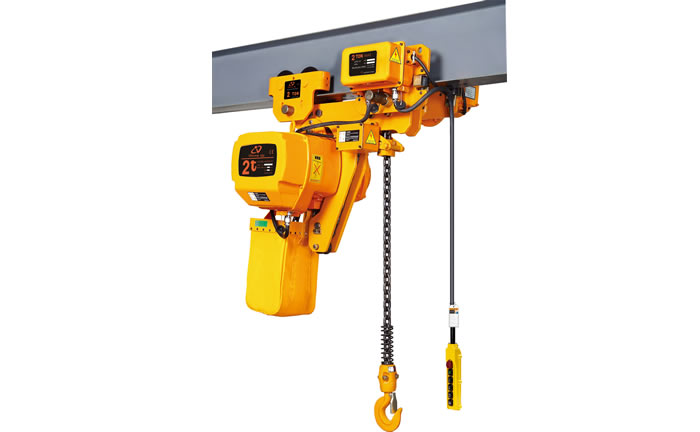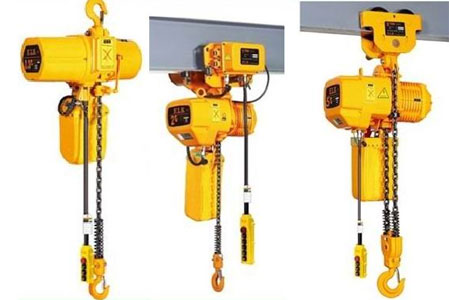Projects
Different Types of Electric Hoist for Sale - Feature, Advantages and Application
Lifting Capacity: 0.25~80t ton
Span: m
Lifting Height: 3~50m m
Working Class: A3, A4,A5
Note: We can design and manufacture the crane according your requirments and working conditions.
An electric hoist is a mechanical device used for lifting and lowering heavy objects. It is powered by electricity and features a motor-driven mechanism for raising and lowering loads. Electric hoist are available in various configurations to suit different applications.
Electric hoist use an electric motor to turn a drum or pulley, which is connected to a rope, chain, or cable. When the motor operates, it winds or unwinds the lifting medium, allowing the hoist to raise or lower the load. The operator controls the hoist using a pendant control or a remote control device.
Different Types of Electric Hoist for Sale:
1. European-Spec Electric Hoist for Sale:
- Features: European-spec electric hoist are designed to meet European safety and quality standards. They often come with advanced safety features and precision engineering.
- Advantages: High safety standards, compact design, precise lifting, and easy maintenance.
- Applications: Commonly used in various industries, including manufacturing, automotive, and construction, where safety and precision are paramount.
2. Single Speed Wire Rope Electric Hoist for Sale:
- Features: These hoists have a single lifting speed, making them straightforward to operate.
- Advantages: Simple operation, cost-effective, and suitable for basic lifting tasks.
- Applications: Ideal for light to medium-duty lifting in workshops, warehouses, and small-scale construction.
3. Double Speed Wire Rope Electric Hoist for Sale:
- Features: Double speed hoists offer both high and low-speed settings for greater control over lifting operations.
- Advantages: Versatile, precise load positioning, and the ability to handle a wider range of tasks.
- Applications: Used in applications where precise load positioning or controlled movement is necessary, such as manufacturing and maintenance.
4. Explosion-Proof Electric Hoist for Sale:
- Features: Explosion-proof hoists are designed to operate safely in potentially explosive atmospheres by preventing the risk of sparks or ignition.
- Advantages: Ensures safety in hazardous environments, reduces the risk of explosions, and protects personnel and equipment.
- Applications: Found in industries with flammable gases, vapors, or dust, such as petrochemical plants and mining.
5. Electric Chain Hoist for Sale:
- Features: Electric chain hoists use a chain as the lifting medium and are known for their robustness and durability.
- Advantages: Strong and durable, easy to operate, and can handle various load types.
- Applications: Commonly used in manufacturing, construction, and maintenance for lifting heavier loads or loads with irregular shapes.
6. Metallurgical Electric Hoist for Sale:
- Features: These hoists are specially designed to withstand harsh and corrosive environments often found in metallurgical applications.
- Advantages: Resistant to corrosion, high durability, and reliability in challenging conditions.
- Applications: Found in steel mills, foundries, and metallurgical plants for handling molten metal, heavy metals, and related materials.
7. Traditional Electric Hoist Trolley for Sale:
- Features: Traditional hoists with a trolley mechanism for horizontal movement.
- Advantages: Simple design, easy to install, and cost-effective.
- Applications: Used in various industries for basic lifting and material handling tasks, often with limited horizontal movement needs.
8. European-Spec Electric Hoist Trolley for Sale:
- Features: Trolley-equipped hoists designed to meet European safety and quality standards.
- Advantages: High safety standards, precise horizontal movement, and durability.
- Applications: Used in industrial settings where both precise lifting and horizontal movement are essential, such as manufacturing and logistics.
The choice of electric hoist type depends on your specific lifting needs, safety requirements, and the operating environment. Always ensure that the hoist you select matches your application's demands to ensure efficient and safe lifting operations.
Electric hoist control method:
Electric hoist for sale are controlled through various methods to operate their lifting and lowering functions and, in some cases, trolley movements. Here are some common electric hoist control methods:
- Pendant Control: Pendant controls are handheld devices with buttons or levers that allow the operator to control the hoist's movements. They typically have two or more buttons for lifting and lowering and may include additional controls for trolley movement or speed adjustment. Pendant controls are connected to the hoist by a cable.
- Remote Control: Some electric hoist for sale are equipped with wireless remote control systems, which provide greater operator mobility and flexibility. These remotes use radio frequencies to communicate with the hoist. Remote controls are particularly useful when the operator needs to be at a distance from the hoist during operation.
- Radio Remote Control: Similar to pendant controls but without the physical connection, radio remote controls use radio signals to send commands to the hoist. Operators can control the hoist from a distance, making them ideal for applications where proximity to the hoist may not be practical.
- Variable Frequency Drives (VFDs): VFDs allow for the precise control of the hoist's speed and acceleration. By adjusting the frequency of the electrical power supplied to the hoist motor, VFDs enable smooth and controlled movements, which are especially useful for applications requiring precise load positioning.
- PLC (Programmable Logic Controller) Integration: Some hoists are integrated with PLC systems to automate and control hoist operations as part of a larger industrial process. PLCs can be programmed to execute specific lifting and positioning tasks.
The choice of control method depends on the specific hoist model, the application, and the operator's preferences. Safety is paramount, so proper training and adherence to safety guidelines are essential regardless of the control method used. Additionally, it's important to choose a control method that suits the complexity and requirements of the lifting task and to ensure it complies with safety regulations and standards.
Comparing Electric Hoist for Sale Control Options: Remote Control vs. Pendant Control:
When it comes to electric hoist for sale control options, two common choices are remote control and pendant control. Here's a comparison of remote control and pendant control for electric hoist:
Remote Control:
- Operator Mobility: Remote controls offer the advantage of operator mobility. Operators can control the hoist from a distance, providing better visibility and safety when lifting and lowering loads.
- Versatility: Remote controls are versatile and can be used with various hoist models and types, including electric chain hoists and wire rope hoists.
- Reduced Operator Fatigue: Operators can adjust their position for better ergonomics and reduced fatigue, as they are not tethered to a fixed control station.
- Safety: Remote controls can provide additional safety features, such as emergency stop buttons and collision avoidance systems.
- Precise Control: Some remote controls offer fine-tuned control over hoist movements, which can be essential for tasks requiring precision.
Pendant Control:
- Cost-Effective: Pendant controls are typically more cost-effective than remote control systems.
- Durability: Pendant controls are known for their durability, making them suitable for harsh industrial environments.
- Direct Connection: Pendant controls are directly connected to the hoist, eliminating potential signal interference issues.
- User-Friendly: Pendant controls are often user-friendly and familiar to operators, as they are similar to traditional switches or levers.
Remote controls are excellent for applications where operator mobility and visibility are crucial, such as construction sites, outdoor work, or operations involving large loads and complex load paths.
Pendant controls are well-suited for indoor applications with limited operator movement requirements, as well as tasks that prioritize cost-effectiveness and simplicity.
Ultimately, the choice between remote control and pendant control depends on your specific application, budget, safety considerations, and the degree of operator mobility and control precision required for the task at hand. In some cases, a combination of both control methods may be ideal for certain applications.
How to choose the right electric hoist for your lifting needs:
Choosing the right electric hoist for your lifting needs is crucial to ensure the safety and efficiency of your lifting operations. Here are the key factors to consider when making your selection:
- Load Capacity: Determine the maximum weight you need to lift. Choose an electric hoist for sale with a load capacity that exceeds your heaviest load to provide a safety margin.
- Lift Height: Consider the vertical distance the load needs to be raised or lowered. Select a hoist with a lift height that meets or exceeds your requirements.
- Duty Cycle: Assess how frequently you'll be using the hoist. Electric hoist have different duty cycles, such as intermittent use, frequent use, or continuous use. Choose one that matches your application's demands.
- Speed and Control: Determine the required lifting and lowering speed for your application. Some hoists offer variable speeds, which can be beneficial for tasks that require precision. Consider the control method that suits your operational needs, whether it's pendant control, remote control, or other options.
- Power Supply: Ensure that your facility has the appropriate power supply to operate the hoist. You may need to make electrical modifications if necessary.
- Environmental Conditions: Consider the environment where the hoist will be used. Some hoists are better suited for harsh conditions, such as explosion-proof hoists for hazardous areas or metallurgical hoists for corrosive environments.
- Safety Features: Look for safety features such as overload protection, emergency stop buttons, and limit switches. Safety is paramount in lifting operations.
- Trolley System: If your application requires horizontal movement of the load, choose a hoist with an appropriate trolley system. Options include manual trolleys, electric trolleys, or hoists with integrated trolleys.
- Mounting and Positioning: Ensure that you have a suitable mounting structure or support for the hoist. Proper positioning is essential to prevent unintended swinging or movement of the load.
- Brand and Quality: Choose reputable brands and high-quality hoists known for durability and reliability. Quality hoists are less likely to break down, ensuring consistent performance and long-term cost savings.
- Budget: Consider your budget constraints. While it's important to invest in a reliable hoist, you should also ensure it aligns with your financial capabilities.
Electric hoist safety considerations:
Electric hoist are powerful tools for lifting heavy loads, but they also pose safety risks if not used correctly. Here are important safety considerations when working with electric hoist:- Load Capacity: Never exceed the hoist's rated load capacity. Overloading can lead to equipment failure and accidents. Know the weight of the load you intend to lift.
- Overload Protection: Use overload protection devices, such as limit switches or load cells, to prevent overloading. These devices can automatically stop the hoist when the load exceeds safe limits.
- Safety Devices: Ensure that the hoist is equipped with safety features, such as emergency stop buttons, limit switches, and thermal protection to prevent overheating.
- Operator Training: Ensure that only trained and authorized personnel operate the electric hoist. Proper training is essential for safe operation.
- Regular Inspection: Perform routine inspections of the hoist and its components. Look for signs of wear, damage, or malfunction. Address any issues promptly.
- Environmental Conditions: Consider the environment where the hoist will be used. Factors like temperature, humidity, and exposure to corrosive substances can affect the hoist's performance. Take appropriate measures to protect the hoist from these conditions.
- Secure Mounting: Properly install and securely mount the hoist to a suitable structural support. Ensure that the mounting structure can handle the hoist's load capacity.
- Positioning: Position the hoist to minimize swinging or unintended movements of the load. Use taglines or guide ropes, if necessary, to control load sway.
- Control Devices: Use control devices, such as pendant controls or remote controls, to operate the hoist from a safe distance. Always maintain clear visibility of the load during operation.



